| After the turn of the century, the masculine tailored look of the 1890s gives way to a look of ultimate femininity. 1901 starts out the era with the Trumpet Skirt; a shaped skirt that is fitting over the hips and thighs, then flaring out below the knee for a wide hem, typically in either 5 or 7 gores. Very quickly, the slim skirts begin to get fuller at the hem, with the addition of vertical pleats and tucks around the skirt, though the skirt remains lean and controlled through the thigh. The Edwardian style begins in 1902 with the introduction of the straight front corset, and the S-bend or pigeon-breasted figure. The emphasis was placed on an overall slimness of the female form, and corsets were designed to compress the waist and lower abdomen, but no longer support the bosom. The bosom now became the lowered mono-bosom, made possible by the use of various methods of exaggeration, such as ruffles, padding, pneumatics, or bust forms. The addition of a rump pad under the back hip of the corset finished the illusion of the arched back and rounded hips. The 1890’s saw the introduction of the Blousewaist and Shirtwaist, but the Edwardian Era saw them reign supreme. As the new century unfolds, the fitted bodice looses favor. The new style becomes full through the lower ribs and the bust shifts to a lower position. | 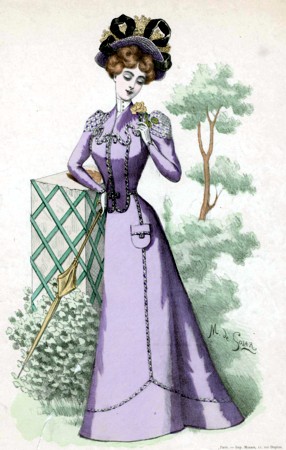 c1900 – L’art et la Mode
c1900 – L’art et la Mode
|
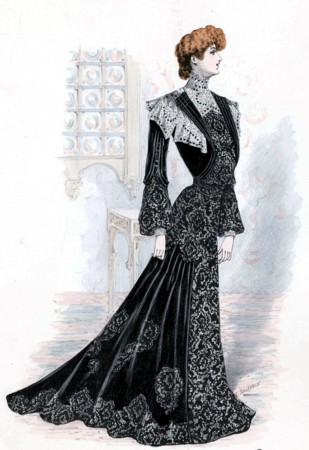 1902 Jan – Le Grandes Modes de Paris
1902 Jan – Le Grandes Modes de Paris
|
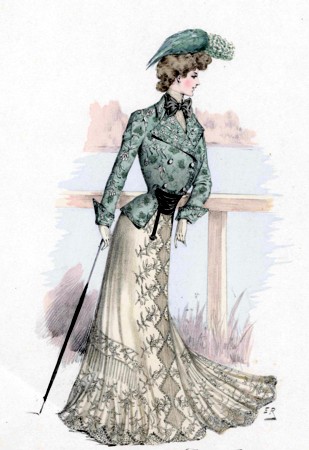 1902 June – Les Grande Modes de Paris
1902 June – Les Grande Modes de Paris
|
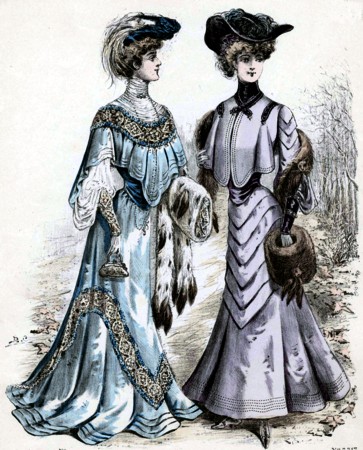 1903 – Journal des Demoiselles.
1903 – Journal des Demoiselles.
|
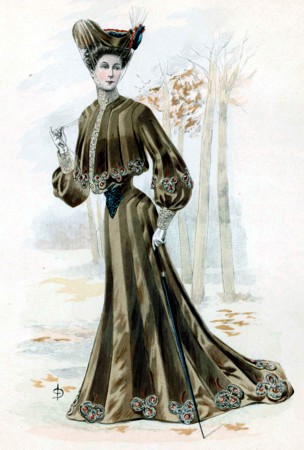 1903 Dec – La Mode Illustre
1903 Dec – La Mode Illustre
|
| 1904 brings an expansion of the skirts through the thigh, and the shaping slips away to reveal full, straight gores. Additional gores are added, and the 9 and 11 gore skirts begin to appear. Up to 24 gores even. And the pleats get ever more complicated. As the skirts reach their fullest, 1905 sees the introduction of the circular skirt, cut all in one piece. 1906 begins a slimming trend to the skirt, ever slimmer with straight gores, which continues through the end of the decade.Trimmings on skirts for this period are flat, with the occasional ruffle being seen. Fabrics are light and flowing woolens, muslins, and linens; and skirts are no long lined, except for a separate “foundation skirt” of silk taffeta. Multi layered petticoats are needed to help support the skirts, and are often the most expensive part of the wardrobe. In the early years of the decade, the sleeves are slim at the shoulder, and full at the wrist. By 1904, the fullness had moved up to the elbow, with tall fitted cuffs to the wrist. By 1906, the fullness is at the shoulder. | 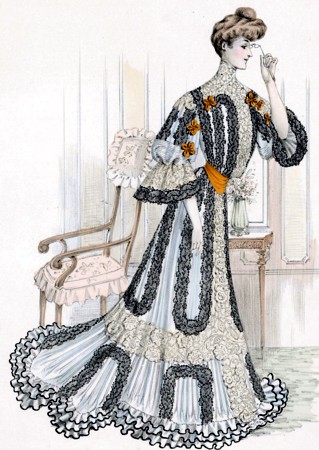 1904 Dec – Les Grands Modes de Paris
1904 Dec – Les Grands Modes de Paris |
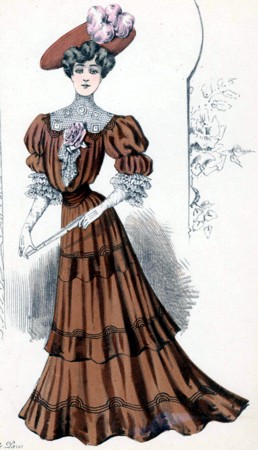 1904 Sept – Les Grands Modes de Paris
1904 Sept – Les Grands Modes de Paris |
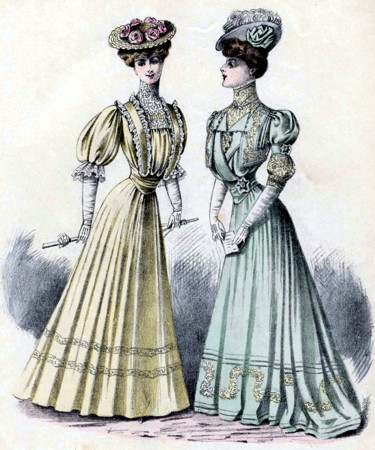 1906 June – Journal de Demoiselles
1906 June – Journal de Demoiselles |
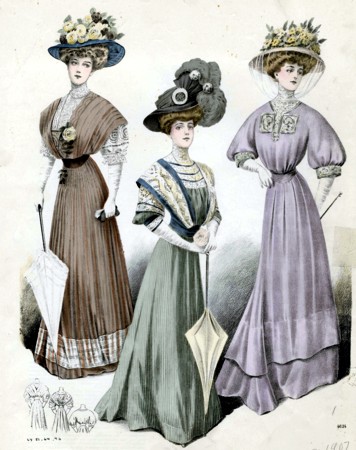 1907 – De Gracieuse
1907 – De Gracieuse |
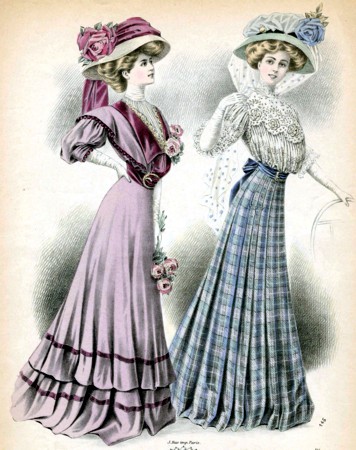 1907 – La Salon de la Mode
1907 – La Salon de la Mode |
| Necklines are typically very high, with decorated, detachable stock collars. The Duchess Square, Duchess Round, and Jewel necklines all become popular, with or without a gimp to fill in the neckline. As the skirts gain pleats and fullness, so do the blouses. Tucks, and pleats are added to the shoulders and sleeves. Or fullness is gathered onto yokes. By 1905, a slimmer look through the ribs is desired, and tall, shaped belts are added to emphasize a small waistline. By 1907, the Jumper made it’s debut, as a loose overblouse, typically of the same fabric as the skirt, and with an open neckline and sleeves to show a gimp or fitted blouse underneath. Beginning in 1909, the full skirts from earlier in the decade rapidly narrow down to a slim silhouette. While not as narrow as the modern pencil skirt, is was at the time, the slimmest that any skirts had been in ages, which earned them the name of “Hobble Skirt.” Kick pleats hidden in seams allowed for a longer stride without adding fullness. Very quickly, these pleats became more decorative and the multitude of variations added individuality to the otherwise universal silhouette. While daytime styles were slim, straight lines, and decorated with pleats, lapped seams, and buttons, formal wear and evening styles were often elaborately draped and flowing with puffs and swags. By 1913, the draped styles were creeping into the daytime styles as well, especially by French designers. The skirts get a bit narrower 1913-14, but start to get wider again by the end of 1915, when the skirts take on more of an A-line shape. By 1916, the skirts begin to get quite full, and shorten up to as much as 3-4″ above the ankle. | 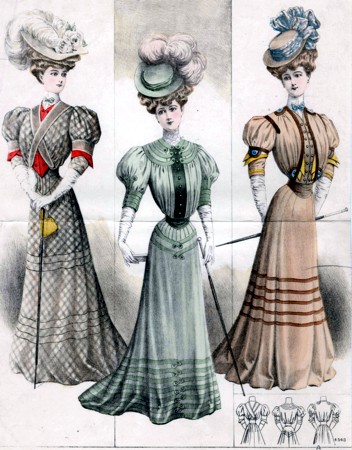 1907 – La Moda Ellegant Illustrada
1907 – La Moda Ellegant Illustrada |
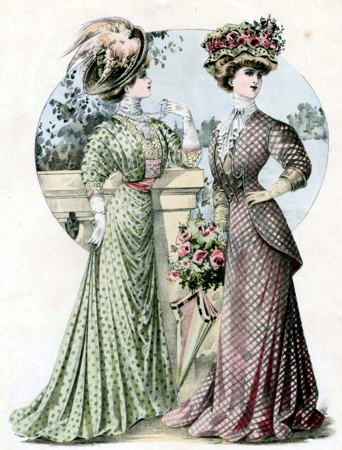 1908 May – Journal Des Demoiselles
1908 May – Journal Des Demoiselles |
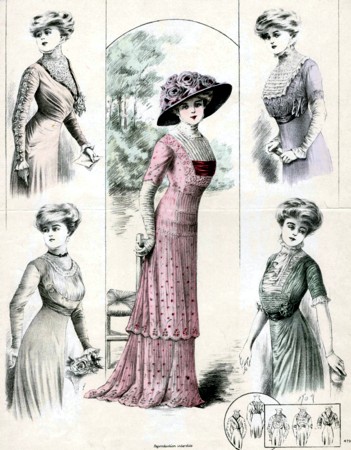 1909 June – La Moda Elllegante Illustrada
1909 June – La Moda Elllegante Illustrada |
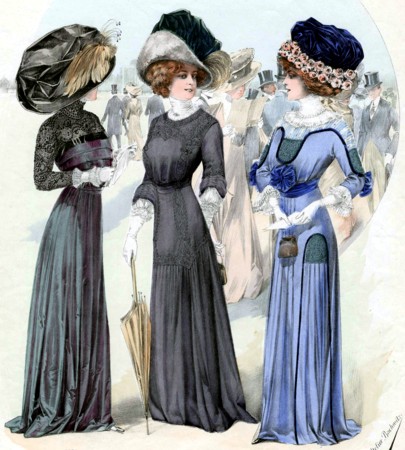 1909 Sept – Chic Parisien.
1909 Sept – Chic Parisien. |
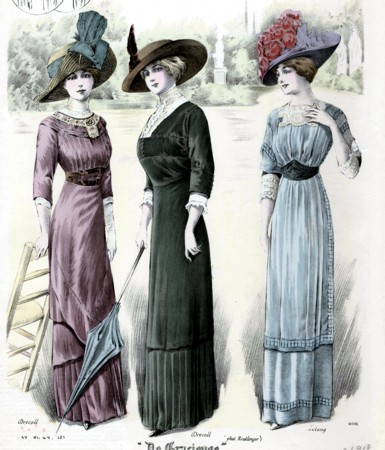 1910 – De Gracieuse
1910 – De Gracieuse |
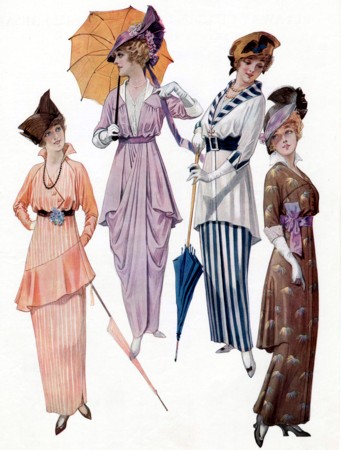 1914 July – The Delineator
1914 July – The Delineator |
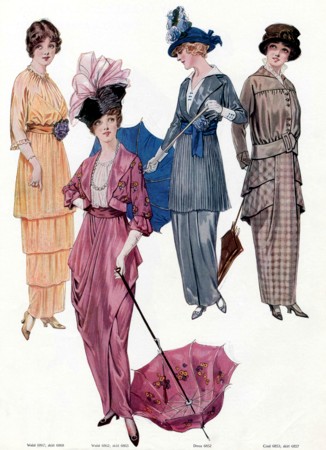
1914 May – The Delineator |
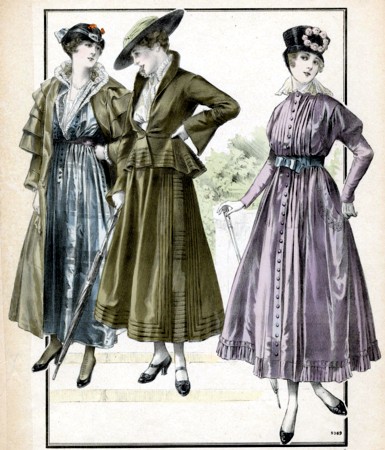 1916 – De Gracieuse
1916 – De Gracieuse |